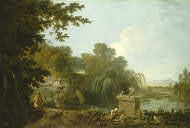
|
Richard Wilson (artist) Welsh, 1712/1714 - 1782 Solitude, c. 1762/1770 oil on canvas Overall: 142.1 x 210.1 cm (55 15/16 x 82 11/16 in.) framed: 163.8 x 231.6 x 7.6 cm (64 1/2 x 91 3/16 x 3 in.) Paul Mellon Collection 1983.1.45 |
Object 6 of 8
Richard Wilson, who began as a portraitist, became Britains’ first major landscape painter. During a seven- to eight-year stay in Italy in the 1750s, he realized that landscapes could be metaphors of the human condition. Inspired by the arcadian scenes painted in seventeenth-century Rome by Claude Lorrain, Wilson produced evocative vistas that combine classical grandeur with English rusticity. One of the thirty-six initial members of the Royal Academy of Arts in 1769, Wilson found patrons among British gentlemen who had taken Grand Tours of Italy.
The Mediterranean scenery here, including the sunlit church and smoking volcano, evokes memories of Italy. But, the woodland glens and the cavern by the brook are distinctly English. Three hermits inhabit this shadowed grove. The two at the left are robed as Christian monks, while the partial nude at the right may be a pagan priest. He lies beside a crumbled statue of a lion, symbolic of civilization’s vanities.
The romantic subject recalls poetic lines in The Seasons, a long blank verse finished in 1730 by James Thomson:
“…And all is awful, silent gloom around.
These are the haunts of Meditation, these
The scenes where antient Bards th'inspiring breath,
Extatic, felt; and, from this world retird.”
| « | back to gallery | » | continue tour |


